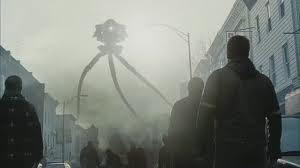 |
| arunbains.blogspot.com |
War of the Worlds (2005), originally done in 1953, depicts Tom Cruise as a divorced father of two who, in the middle of being invaded by Martians, attempts to get back in his children's' lives. There are many elements of cinematography in the film, such as props, plot, narration, editing and characters, etc. The prop is defined in Corrigan & White (2009) in the following quote. “The prop, (short for property) is an object that functions as a part of the set or is a tool used by the actors” (69).
 |
| ask.com |
A prop(s) in War of the Worlds (2005) in one scene, for example, would be the laundry hanging from the clothesline outside. In the scene where a storm, or lightening, attacks the city, violent winds moves the laundry wildly about, and the camera is looking at a mother standing there holding her frightened child. While the laundry would normally signify comfort and contentment, this scene shows the laundry moving frantically out of place to show discomfort, as if to show something is out of place, that something out of the ordinary is about to happen.
 |
| ahashare.com |
Narration occurs in the beginning of the film when Morgan Freeman is introducing the film by giving insight about how people are so comfortable in their own stagnancy, and are afraid of change, closed to think outside the box and live and think differently than how they do. The course text defines Narration as follows. “Narration refers to the emotional, physical, or intellectual perspective through which the characters, events, and action of the plot appear” (235).
 |
| kwdownloads.com |
In the film, the focus is on a man who, like many of the people in the film, is stuck in his own world of not taking events or people in his life as seriously as he should; or in his particular case, not taking his responsibilities as a father and former husband, to heart. Now he is living his own life with no responsibilities (no food in his refrigerator) even though he knows his kids are coming over; he does not help his daughter Rachel when she is getting her luggage from the van, and he is not as emotional or sensitive to his kids' feelings like he should be, being a father and all...
 |
| ew.com |
In conclusion, in the film we also see many instances of graphic editing involved. Considering the fact that Steven Spielberg directed this movie, many circular shapes are depicted throughout the film, as it has been said that he favors them very much. Corrigan & White (2009) defines graphic editing in the quote, “[...] are such formal patterns as shapes, masses, colors, lines and lighting patterns within images” (158).
 |
| monova.org |
For example, in the beginning of the film, a microscopic, circular image of a rain drop is shown, as well as the world in its entirety. Also showing these circular images are scenes including trucks, where their wheels are shown up close; and most remembered by me particularly is the scene where Ray and his son, Robbie, are playing catch out in the front yard. In the middle of an argument, Robbie ducks on Ray's hard fast ball into his own window, creating a small circular hole that blended in nicely with Ray's cluttered kitchen and malnourished yard.
Works Cited:
Corrigan, Timothy, and Patricia White. Film Experience: an Introduction. 2nd ed. New York, NY: Bedford/St. Martins, 2009. Print.
Cruise, Tom, Dakota Fanning, and Tim Robbins, perf. War of the Worlds. Dir. Steven Spielberg. 2005. Paramount Pictures, 2005. DVD.










